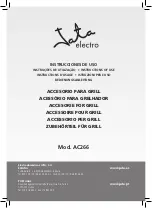
D-302894
3
(1) A smoke detector installed in each separate sleeping area (in the
vicinity, but outside the bedrooms), and (2) Heat or smoke detectors
in the living rooms, dining rooms, bedrooms, kitchens, hallways,
attics, furnace rooms, closets, utility and storage rooms, basements
and attached garages."
3.3 Where Not to Install Smoke
Detectors
False alarms occur when smoke detectors are installed where they
will not work properly. To avoid false alarms, do not install smoke
detectors in the following situations:
•
Combustion particles are by-products of something burning. Do not
install smoke detectors in or near areas where combustion particles
are present, such as kitchens with few windows or poor ventilation,
garages where there may be vehicle exhaust, near furnaces, hot
water heaters and space heaters.
•
Do not install smoke detectors less than 6 meters (20 feet) away
from places where combustion particles are normally present, like
kitchens. If a 20-foot distance is not possible, try to install the
detector as far away from the combustion particles as possible,
preferably on the wall. To prevent false alarms, provide good
ventilation in such places.
IMPORTANT:
Never try to avoid false alarms by disabling the
detector.
•
Do not mount smoke detectors in the path of fresh air intake. The
flow of fresh air in and out can drive smoke away from the smoke
detector; thus reducing its efficiency. Figure 8 indicates the correct
and incorrect locations concerning this problem.
•
Near paint thinner fumes.
•
In close proximity to an automobile exhaust pipe; this will damage
the detector.
•
In damp or very humid areas or near bathrooms with showers.
Moisture in humid air can enter the sensing chamber, then turns
into droplets upon cooling, which can cause false alarms. Install
smoke detectors at least 3 meters (10 feet) away from bathrooms.
•
In very cold or very hot areas, including unheated buildings or
outdoor rooms. If the temperature goes above or below the
operating range of smoke detector, it will not work properly. Verify
that the temperature range of the detector falls within the Operating
Temperature, (see chapter 2. Specifications).
•
In very dusty or dirty areas, dirt and dust can build up on the
detector's sensing chamber, to make it overly sensitive.
•
Additionally, dust or dirt can block openings to the sensing
chamber and keep the detector from sensing smoke.
•
Near fresh air vents or very drafty areas like air conditioners,
heaters or fans. Fresh air vents and drafts can drive smoke away
from smoke detectors.
•
Dead air spaces are often at the top of a peaked roof, or in the
corners between ceilings and walls. Dead air may prevent smoke
from reaching a detector. See Figures 6 and 7 for recommended
mounting locations.
•
In insect-infested areas. If insects enter a detector's sensing
chamber, they may cause a false alarm. Where bugs are a
problem, get rid of them before putting up a detector.
•
Near fluorescent lights, electrical "noise" from fluorescent lights
may cause false alarms. Install smoke detectors at least 1.5 meters
(5 feet) from such lights.
•
Smoke detection depends on the smoke density present in a
room. Smoke density is greater in small rooms, for the same
amount of smoke, than in large rooms.
In small rooms less than 25 cubic meters (883 cubic ft.) in size,
a small amount of smoke may activate a smoke alert. For
example, smoking or bathroom steam may activate a smoke
alert.
B
C
D
A
E
F
H
G
A
I
A.
BEDROOM
B.
AIR RETURN
C.
BATH
D.
AIR ENTRY
E.
STOVE
F.
KITCHEN
G.
LIVING ROOM
H.
CORRECT LOCATION
I.
INCORRECT LOCATION
Figure 8.
Recommended Smoke Detector Locations to Avoid Air
Streams with Combustion Particles
WARNING:
Never remove batteries to stop a false alarm. Open a
window or fan the air around the detector to get rid of the smoke. The
alarm will turn itself off when the smoke is gone. If false alarms
persist, attempt to clean the detector as described in this manual.
WARNING:
Do not stand close to the detector when the alarm is
sounding. The alarm is loud in order to wake you in an emergency.
Too much exposure to the horn at close range may be harmful to your
hearing.
3.4 Audible and Visual Indications
The dual color LED and buzzer are used to signal various alarm and
trouble messages as shown in Table 1 below:
Table 1.
Visual and Audible Indications
Visual Indication (LEDs)
Condition
Red Yellow
Audio
Indication
Smoke alarm
Flash every
500ms
-
3 long beeps every
4 sec.
Heat alarm(***) Flash every
500ms
-
Long beep every
2 sec.
Tamper alarm(*)
-
-
Long beep every
2 sec.
Standby
Flash every 30
sec.
- -
Low battery
Flash every 30
sec.
-
Short beep every
30 sec.
Smoke sensor
trouble
Flash every 60
sec.
3 Flashes every
60 sec.
Short beep every
60 sec.
Low sensitivity
alarm
Flash every 30
sec.(**)
-
Short beep every
30 sec.
Heat sensor
trouble(***)
Flash every 60
sec.
5 Flashes every
60 sec.
Short beep every
60 sec.
Need to clean
2 flashes every
30 sec.
-
2 short beeps
every 30 sec.
Test
See par. 6.1
*
The tamper alarm will mute for 3 minutes at first power on, and
will revert to normal mode when the tamper switch condition is
changed.
** Delay of 15 sec. between buzzer beep and LED operation
*** SMD-427 only
3.5 Battery Connection and Initial Test
Attention:
The detector battery cover is fitted with a red button that
prevents the detector from locking onto bracket if there is no battery
inside.
The smoke detector is supplied with a 3V CR123A / CR17450 battery.
Battery connection for both types of batteries is illustrated in Figures
9a and 9b below.


























